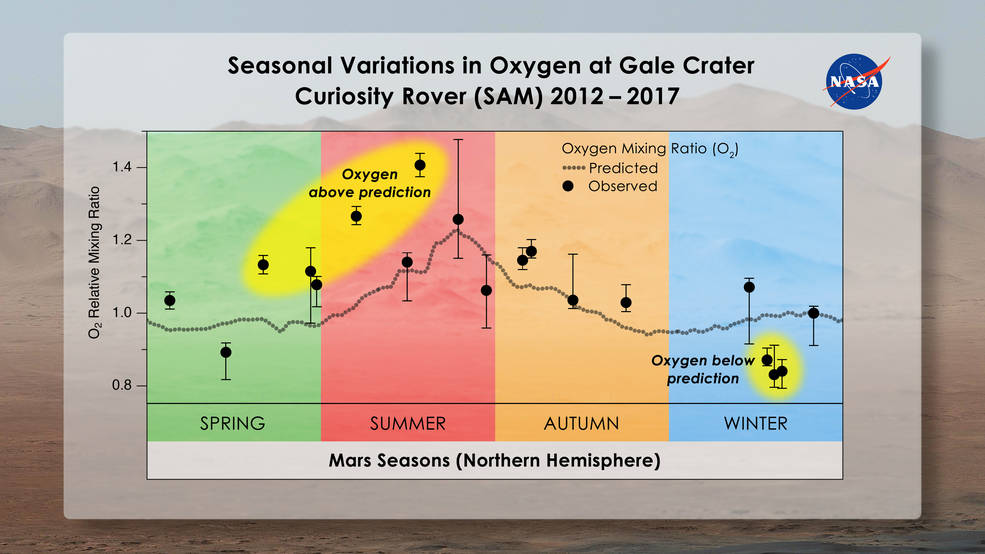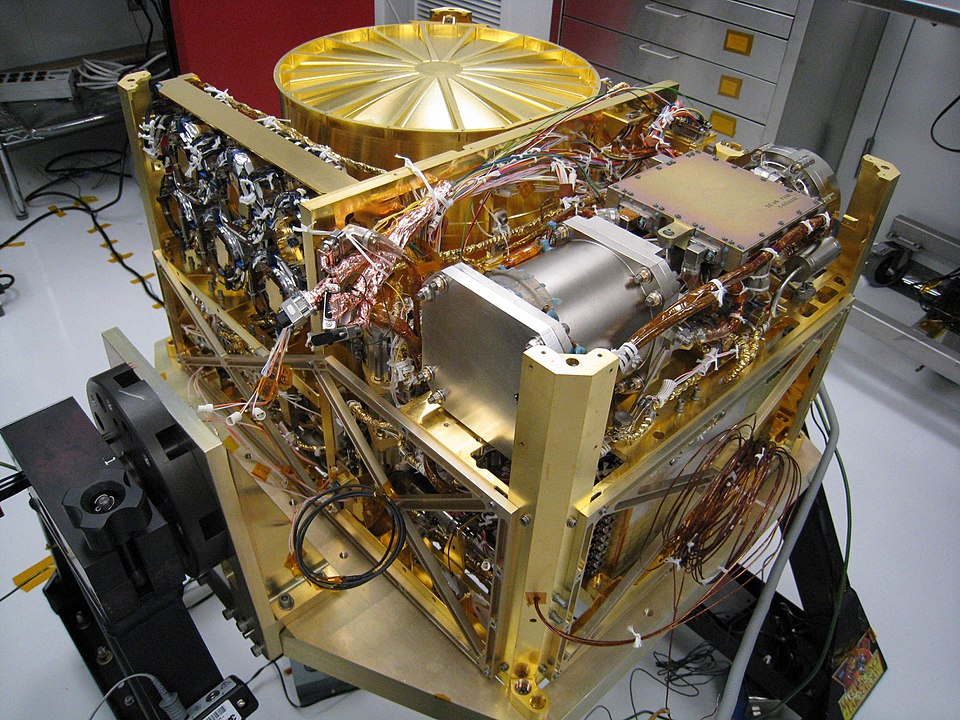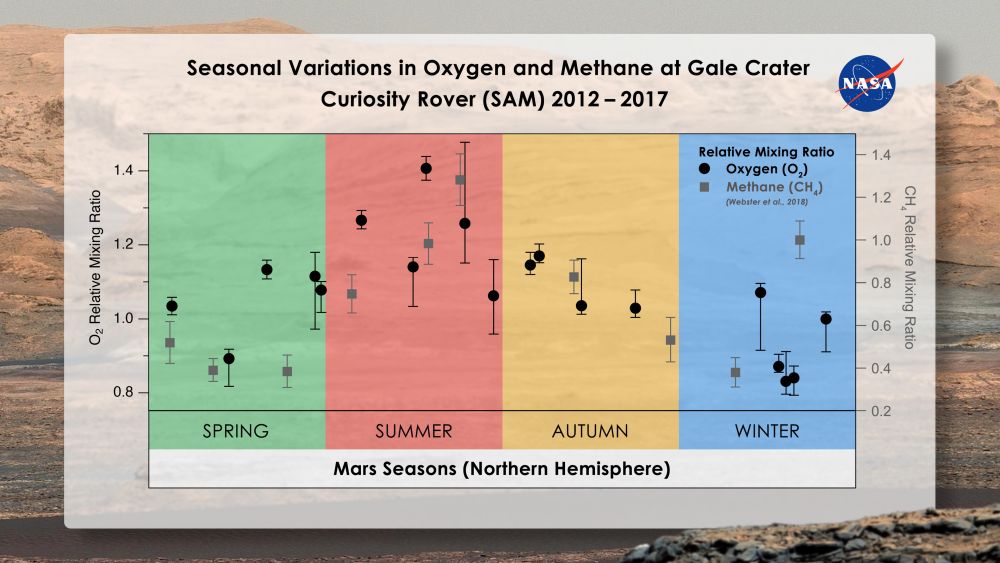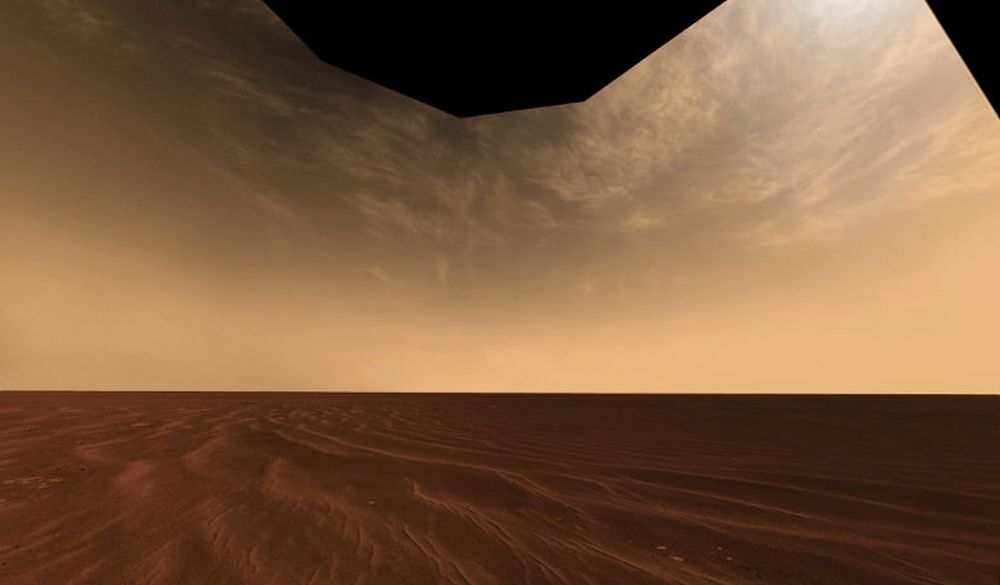An atmospheric drama has been playing out on Mars lately. Up until now, the main actor has been methane, and its unusual, spiking behaviour. But now Oxygen is taking the stage, and performing some theatrics of its own.
NASA’s Curiosity rover is busy examining Mars to see if it could have supported microbial life in the past. Its main focus is the rocks that make up the planet, and all the secrets locked in those rocks. But sometimes it comes up for air, and takes regular atmospheric measurements with SAM, the Sample Analysis at Mars instrument suite.
SAM can measure and analyze organics and gases in the Martian atmosphere, and it can try to determine if a gas has a biological origin or a geochemical origin. For three Martian years, Curiosity has used SAM to measure the atmosphere at Gale Crater and track changes.
This is the atmospheric composition at the surface of Mars:
- carbon dioxide: 95%
- molecular nitrogen: 2.6%
- argon: 1.9%
- molecular oxygen: 0.16%
- carbon monoxide: 0.06%
But the composition of the atmosphere changes through the seasons. During Martian winter, CO2 freezes and lowers the atmospheric pressure. In summer, the CO2 sublimates and raises the atmospheric pressure. Curiosity found that in Gale Crater, nitrogen and argon compositions wax and wane with the seasons, due to the changing atmospheric pressure, which makes sense.
Scientists assumed that the oxygen concentration would do the same, but it hasn’t. Its behaviour in the atmosphere doesn’t repeat from season to season, and they’re not sure why.
“This is the first time where we’re seeing this interesting behavior over multiple years.”
Melissa Trainer, Research Lead, planetary scientist at NASA’s Goddard Space Flight Center
A paper discussing these findings was published on Nov. 12th in the Journal of Geophysical Research: Planets. The title is “Seasonal variations in atmospheric composition as measured in Gale Crater, Mars.” The research lead is Melissa Trainer, a planetary scientist at NASA’s Goddard Space Flight Center.

In a press release, Trainer said, “We’re struggling to explain this. The fact that the oxygen behavior isn’t perfectly repeatable every season makes us think that it’s not an issue that has to do with atmospheric dynamics. It has to be some chemical source and sink that we can’t yet account for.”
“The first time we saw that, it was just mind boggling,” said Sushil Atreya, professor of climate and space sciences at the University of Michigan in Ann Arbor. Atreya is a co-author of a the paper.
As the authors make clear in their paper, “The SAM measurements of O2 in Gale crater do not show the annual stability or seasonal patterns that would be predicted based on the known sources and sinks in the atmosphere.” So what’s causing them?
First of all, they don’t know. But it’s worth pointing out the accuracy of the measurements. The authors say that, “The atmospheric compositional data obtained by the SAM instrument in Gale Crater offer unprecedented seasonal and multi-year coverage of the Mars atmosphere at the surface.” The measurements spanned three Martian years, ample time to account for seasonal changes due to Mars’ obliquity and its pronounced orbital eccentricity. The measurements also spanned a much longer time than the Viking landers’ measurements, the only other surface atmospheric measurements we have. Those only lasted a few days.

“We have not been able to come up with one process yet that produces the amount of oxygen we need, but we think it has to be something in the surface soil that changes seasonally because there aren’t enough available oxygen atoms in the atmosphere to create the behavior we see,” said Timothy McConnochie, assistant research scientist at the University of Maryland in College Park and another co-author of the paper.
Mars has abundant oxidants at its surface, and that gives it the potential to produce significant O2. But as the authors say in their paper, “… the mechanisms by which O2 could be quickly generated and then quickly destroyed are completely unknown.”
Completely unknown. As in totally. But there’s a sliver of hope at least that there may be some biological source involved in these unaccounted for fluctuations.
This oxygen problem is parallel to the methane (CH4) problem encountered by scientists studying Mars.

Methane exists in Mars’ atmosphere, though only in exceedingly small concentrations. In the Gale Crater, it’s barely measurable, though MSL Curiosity has detected it at a concentration of 0.00000004% on average. SAM’s Tunable Laser Spectrometer can detect it, and has sensed an expected seasonal rise and fall. But what is so far unexplained is methane’s 60% increase in the summer months.
The methane issue has been reported on extensively, so there’s no need to rehash the details here. It’s sufficient to recount that methane seems to be released from distinct regions on Mars. Since methane only persists in the atmosphere for about four years at the most, it keeps being produced somewhere.
Both oxygen and methane can have biological sources. But both can also have abiotic sources. These surprising results don’t help answer the question of life on Mars. MSL Curiosity can’t tell if the oxygen and methane have biological sources: it doesn’t have the instruments. For now, most scientists think that non-biological sources are more likely.
The methane measurements and the O2 measurements show us that Mars is a complex world, with atmospheric dynamics that scientists are only beginning to understand. Whether life plays some role in the shaping of Mars’ atmosphere is an open, and intriguing, question.

As the authors say in their summary, “Geophysical and geochemical results have painted a picture of a formerly habitable planet billions of years in Mars’ past, and measurements of current processes provide indications that Mars may still potentially harbor habitable environments.”
In the press release, research lead Melissa Trainer issued a friendly, scientific challenge of sorts:
“This is the first time where we’re seeing this interesting behavior over multiple years. We don’t totally understand it,” Trainer said. “For me, this is an open call to all the smart people out there who are interested in this: See what you can come up with.”

